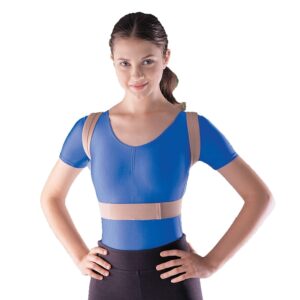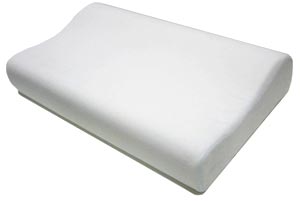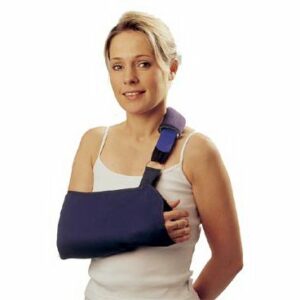Shoulder Pain Diagnosis Guide
Updated:
Optimal shoulder function is essential to minimise the likelihood of injury during everyday use of the arm and for those involved in sports using the upper body such as racquet sports or the throwing athlete. Patients suffering from shoulder pain are often seen in physiotherapy practice. Pain may be caused by local structures within or around the shoulder or may be referred from other sources (such as the neck or upper back).
One common clinical presentation is the patient suffering from sudden onset shoulder pain typically as a result of a lifting, pushing or pulling activity or a sudden movement (often with the arm in elevation or overhead), the cause of which is often a torn muscle or tendon, typically a Rotator Cuff Tear (figure 1). In patients with gradual onset shoulder pain due to repetitive or prolonged arm elevation, lifting, pushing or pulling activities, general housework or lying on the affected size, Rotator Cuff Tendonitis (figure 1) is the more likely diagnosis, which typically involves gradual degeneration and inflammation of the rotator cuff tendons. In those patients with associated neck, upper back, elbow, forearm, wrist or hand pain, Referred Pain (frequently from the neck or upper back) is often the cause of symptoms. In older patients with gradual onset shoulder pain, Shoulder Arthritis may be the cause of symptoms. There are numerous other causes of shoulder pain, some of which present suddenly due to a specific incident, others which develop gradually over time.
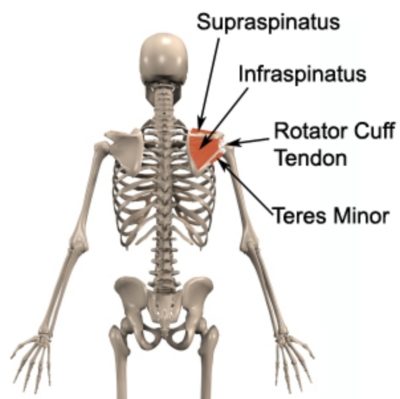
Below are some of the more common causes of pain in the shoulder with a brief description of each condition to aid shoulder pain diagnosis. Conditions have been organised according to sudden or gradual onset and common or less common conditions for ease of use.
Find out what may be causing your shoulder pain:
Sudden Onset Shoulder Pain Diagnosis – Common Injuries
Rotator Cuff Tear
Tearing of one or more rotator cuff muscles or their respective tendons (figure 1), typically following a lifting, pushing or pulling activity or a sudden movement (often with the arm in elevation or overhead). Associated with pain in the shoulder that may radiate into the upper arm and sometimes pain on firmly touching the affected rotator cuff muscle or tendon (figure 1). Pain may also increase during lifting activities (especially with the arm outstretched or above the head) and when lying on the affected side.
Referred Pain
Pain referred into the shoulder from another source such as the neck or upper back, frequently associated with symptoms above or below the shoulder (such as the neck, upper back, arm, elbow, forearm, wrist or fingers). Typically associated with pain on firmly touching the region responsible for the referred pain and / or loss of movement in that region. Sometimes in association with pins and needles or numbness in the affected arm or hand.
Dislocated Shoulder
Tearing of connective tissue surrounding the shoulder joint (figure 2) with subsequent displacement and separation of the bones forming the joint so they are no longer situated next to each other (i.e. the upper arm bone comes out of the socket). Typically occurs as a result of a fall onto an outstretched hand or a direct impact from an object or person and causes severe pain in the shoulder that may radiate down the arm, a feeling of the shoulder ‘popping out’, deformity of the shoulder joint, muscle spasm and sometimes pins and needles or numbness.
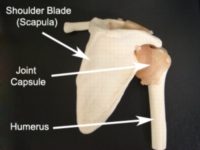
Labral Tear of the Shoulder
Damage to the cartilage lining the shoulder joint (labrum – figure 3) often in association with a dislocated shoulder, or due to a fall onto the arm, heavy lifting, a pushing or pulling movement or a forceful throw. Pain is usually deep, although may present as vague shoulder pain. A clicking or catching sensation is often present during certain movements. Symptoms may increase with certain, often very specific movements or activities using the shoulder such as arm elevation and lifting (especially overhead), weight bearing through the affected arm (e.g. push ups) or sometimes lying on the affected side.
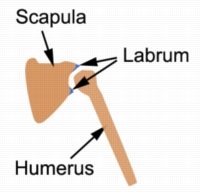
AC Joint Sprain
Tearing of the connective tissue and ligaments of the Acromio-Clavicular joint (AC Joint – figures 4 & 5) typically as a result of a direct impact to the point of the shoulder during a fall or collision. Causes pain at the top of the shoulder that may increase when lying on the affected side, moving the arm across the body and during other shoulder movements. There is also localised tenderness on firmly touching the AC joint (figures 4 & 5).

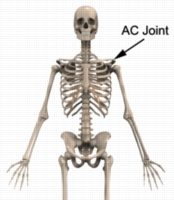
Clavicle Fracture
A break in the collar bone of the shoulder (Clavicle – figure 6) usually due to a fall onto the point of the shoulder of a forceful direct impact to the clavicle. Associated with severe shoulder pain, swelling, tenderness on firmly touching the affected region of the bone and sometimes bony deformity.

Less Common Sudden Onset Injuries
Bicep Strain
Tearing of the biceps muscle (or its respective tendons figure 7) typically due to heavy lifting (such as performing a chin up or bicep curl). Associated with pain in the front of the upper arm, shoulder or elbow and often a pulling or tearing sensation at the time of injury. Pain may increase when firmly touching the injured region of the affected muscle or during lifting or carrying activities (involving the biceps) or when performing a bicep stretch.
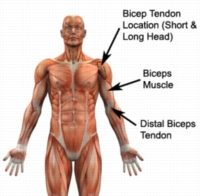
Biceps Rupture
Complete tearing of one or more tendons or muscle bellies of the biceps muscle (figure 7) typically due to heavy lifting (particularly overhead). Associated with pain in the front of the shoulder, upper arm or elbow and often a snapping or tearing sensation at the time of injury. Obvious deformity of the biceps muscle is usually noted when compared to the non injured side especially when contacting the bicep muscle.
Pectoral Strain
Tearing of one or more pectoral muscles (figure 8), typically during a forceful pushing activity (such as performing a bench press). Associated with pain in the front of the shoulder or chest and often pain on firmly touching the affected muscle. Pain may also increase during pushing activities and when performing a pectoral stretch (figure 9).
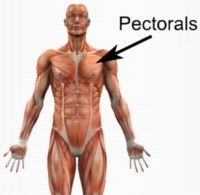
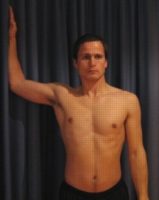
Scapula Fracture
A break in the shoulder blade bone (Scapula – figure 2) usually due to a fall onto the shoulder blade or a forceful direct impact from an object or person. Associated with severe pain in the shoulder blade region, swelling, tenderness on firmly touching the affected region of the bone, markedly reduced shoulder function and sometimes bony deformity.
Humeral Fracture
A break in the upper arm bone (Humerus – figure 2) usually due to a fall onto an outstretched arm, the shoulder itself, or, a forceful direct impact from an object or person. Associated with severe pain in the shoulder, upper arm or elbow, swelling, tenderness on firmly touching the affected region of the bone, markedly reduced shoulder and upper limb function and sometimes bony deformity.
Tricep Strain
Tearing of the tricep muscle (or its tendons figure 10) typically due to heavy pushing activities (such as performing heavy push ups, bench presses, dips or other tricep exercises) or sometimes due to a fall, heavy block (e.g. in lacrosse), explosive throw or excessive stretch. Associated with pain in the back of the upper arm (and sometimes, the shoulder or elbow) and often a pulling or tearing sensation at the time of injury. Pain may increase when firmly touching the injured region of the affected muscle, during pushing activities or when performing a tricep stretch.

Gradual Onset Shoulder Pain Diagnosis – Common Injuries

Members Only ContentBecome a PhysioAdvisor Member to gain full access to this exclusive content. For more details see Become a Member. Already a member? Login Now
Less Common Gradual Onset Injuries

Members Only ContentBecome a PhysioAdvisor Member to gain full access to this exclusive content. For more details see Become a Member. Already a member? Login Now
Diagnosis of shoulder pain
A thorough subjective and objective examination from a physiotherapist is usually sufficient to diagnose the cause of shoulder pain. Investigations such as an X-ray, ultrasound, MRI, CT scan or nerve conduction studies are often required to confirm shoulder pain diagnosis and rule out other injuries.
Find a Physio to assist with shoulder pain diagnosis
Find a physiotherapist in your local area who can assist with shoulder pain diagnosis and can treat patients suffering from shoulder injury.
More Information
- View Shoulder Strengthening Exercises.
- View Shoulder Flexibility Exercises
- View Shoulder Taping.
- View detailed information on when to use Ice or Heat.
- View detailed information on initial injury management and the R.I.C.E. Regime.
Physiotherapy products for shoulder pain
Some of the most commonly recommended products by physiotherapist for patients with shoulder pain include:
To purchase physiotherapy products to assist with rehabilitation click on one of the above links or visit the PhysioAdvisor Shop.

Link to this Page
If you would like to link to this article on your website, simply copy the code below and add it to your page:
<a href="https://physioadvisor.com.au/injuries/shoulder”>Shoulder Pain Diagnosis Guide – PhysioAdvisor.com</a><br/>PhysioAdvisor provides a shoulder pain diagnosis guide for patients suffering from shoulder injuries created by experienced physiotherapists.
Return to the top of Shoulder Pain Diagnosis Guide.

